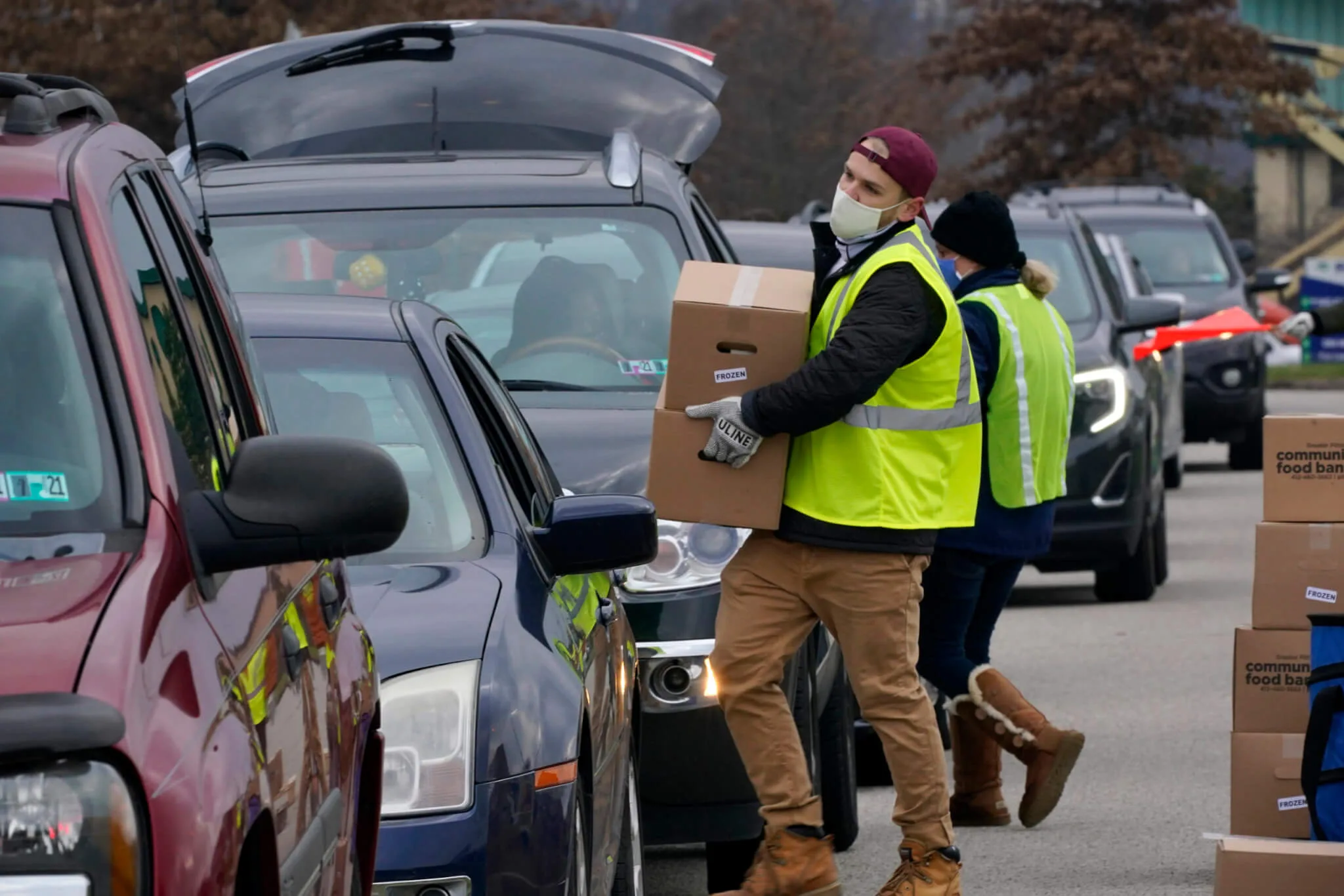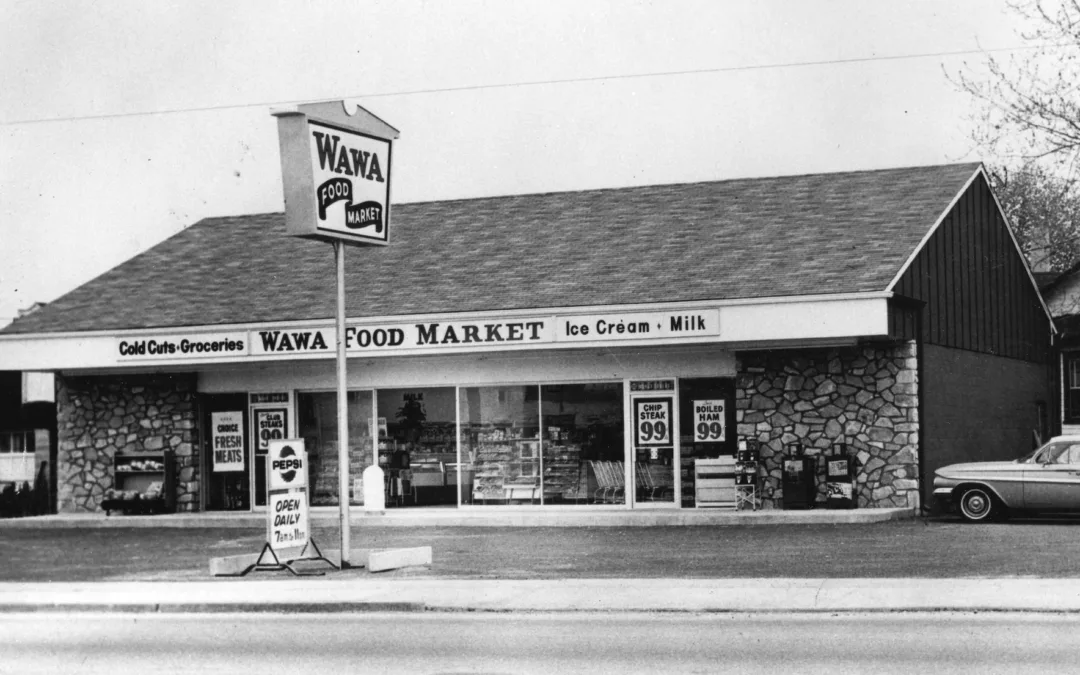
Volunteers load boxes of food into a car during a Greater Pittsburgh Community Food bank drive-up food distribution in Duquesne, Allegheny County, on Nov. 23, 2020. (AP Photo/Gene J. Puskar)
The coronavirus pandemic has created an unprecedented need—for more than just food—in food banks across Pennsylvania.
Joe Arthur was searching for canned vegetables.
So was Jane Clements-Smith.
Meanwhile, their counterparts running food banks in other parts of Pennsylvania grappled with the need for personal protective equipment, cardboard boxes, and money to cover other unexpected expenses.
Getting boxes they now needed to hand out food could wreak havoc on a budget.
The pandemic has made the already difficult task of helping those in the state grappling with food insecurity even more challenging.
Arthur, the executive director of the Central Pennsylvania Food Bank, found the biggest challenge was mainly logistical: How to find enough food for their clients when even grocery stores were struggling with restocking.
“We see that at a larger scale when we’re requiring truckloads of food, which we do every day,” he said. “Some things are harder to get than they used to be—things like canned vegetables and so forth.”
RELATED: Online Grocery Shopping Is Only Available to Food Stamp Recipients in Six States
Clements-Smith, executive director of Feeding Pennsylvania in Cumberland County, also found canned goods scarce.
“I think for us, it’s really about just sourcing enough of family-sized packaged food and then having enough money to do that to keep it moving,” she said.
Changing Procedures and Unexpected Expenses
As part of their coronavirus pandemic safety protocols, many food banks have shifted away from allowing recipients to enter their facilities. To keep clients, volunteers, and employees safe, volunteers pre-pack food in boxes and either hand it out in alcoves or place it directly into car trunks.
This means sturdy cardboard boxes are also in high demand with increased shipping of products directly to consumers, and that makes them costly.
“We had a massive expense in boxes because of doing the pre-packing,” said Jennifer Miller, CEO of Westmoreland County Food Bank. “That’s not something we normally have to purchase. But needing to purchase large enough and strong enough boxes for all that food was definitely an added expense.”
Other added expenses include buying conveyor belts to keep staffers and volunteers 6 feet apart in their warehouse and supplying PPE to workers and pantry-site volunteers.
Some food banks had to move to bigger facilities to allow people to work with plenty of space around them.
Grants from the federal and state agriculture departments helped offset some of these unexpected expenses.
RELATED: SNAP Applications Are Spiking. Advocates Say Congress Needs to Expand the Program Now.
Another logistical issue that popped up was figuring out how to prevent families from having to take long drives. In some rural areas, they could have to trek 30 minutes or longer to get food.
Miller felt fortunate her food bank’s network of community pantries and kitchens remained largely in place. Because of this stability, Westmoreland County Food Bank has avoided mass distributions of food boxes from a single facility that could have forced needy families to drive.
“You’re really not helping because they’re wasting their gas,” she said. “So we felt it was best to stick with our pantry network as long as it was solid and be able to distribute food like we normally do.”
More Need Arises
Rural food banks are also seeing significant changes in the number of families being served.
Jay Worrall, President of Helping Harvest, saw whopping gains in client families over the past nine months. The organization offers assistance in the Reading area.
“There are some months that we’ve seen a 100%increase,” he said. “The full week before Thanksgiving this year, we distributed 380,000 pounds of food. By comparison, in 2019, that same week, we distributed 153,000 pounds of food.”
Other food pantries saw the same growth in need.
“Our latest is more like 200,000 people in a given month,” Arthur said about Central Pennsylvania Food Bank’s new demand. “So we’re up about 40% from where we were last year.”
RELATED: Almost 40% of Military Families Are Struggling to Put Food on the Table
The food insecurity is taking an emotional toll.
Clements-Smith recalled being at a distribution in Westmoreland County and seeing new recipients arrive and handing over a $1 or $5 bill when they got their box.
“They were like, ‘We’ve never had to do this before. I feel guilty, but I’m just at a point where I didn’t have anything in my fridge anymore,’” she said.
At Helping Harvest, new aid recipients are approached while in their vehicles and asked a series of basic enrollment questions. Lately, Worrall said, the drivers are increasingly younger mothers who are new to the process. A question as simple as the number of children living in the home can draw tears.
“I’ve been very surprised by the number of people who come through those lines who very clearly have never received food from us before,” Worrall said.
The emotions swell from both the recipients and the givers.
“We just have so many people who have not experienced getting food from a charitable food network before. And it’s a very moving experience,” Worrall said.
Worrall has worked with housing and people with disabilities as a community organizer. This year has been different.
“I’ve never seen a community understand and respond to a challenge the way I’ve seen it happen with food insecurity.”
Arthur agreed.
“We really appreciate all of the support they’ve given us this year,” he said. “There’s a lot of folks relying on us still and are going to need that for months to come.”
He urged people to keep donating when they can.
“Monetary donations are what we really need because we’re not running food drives. They’re not safe enough with COVID at the scale we work.”
Every dollar donated is maximized as items can be bought in bulk. But any amount of money donated or time volunteered in a warehouse helps ensure no one in Pennsylvania’s rural communities will go hungry this holiday season.
Resources
If you are experiencing food insecurity, or you are not but want to help people who are, contact:
Feeding Pennsylvania, https://feedingpa.org
Central Pennsylvania Food Bank, https://www.centralpafoodbank.org
Westmoreland County Food Bank, https://westmorelandfoodbank.org
Helping Harvest, https://helpingharvest.org
Politics

Malcolm Kenyatta makes history after winning primary for Pa. Auditor General
State Rep. Malcolm Kenyatta, who was first elected to the state House in 2018, won the Democratic nomination for Pa. Auditor General and will...

Biden administration bans noncompete clauses for workers
The Federal Trade Commission (FTC) voted on Tuesday to ban noncompete agreements—those pesky clauses that employers often force their workers to...

Philadelphia DA cancels arrest warrant for state Rep. Kevin Boyle on eve of Pa. primary
Philadelphia District Attorney Larry Krasner said a detective had sought the warrant against Boyle, a Democrat whose district includes a section of...
Local News

What do you know about Wawa? 7 fun facts about Pennsylvania’s beloved convenience store
Wawa has 60 years of Pennsylvania roots, and today the commonwealth’s largest private company has more than 1,000 locations along the east coast....

Conjoined twins from Berks County die at age 62
Conjoined twins Lori and George Schappell, who pursued separate careers, interests and relationships during lives that defied medical expectations,...





